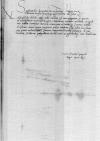List #128
Sigismund I Jagiellon do Ioannes DANTISCUSCracow (Kraków), 1519-01-22
Rękopiśmienne podstawy źródłowe:
Pomocnicze podstawy źródłowe:
Publikacje:
| ||||||||||||||||||||
Tekst + aparat krytyczny + komentarz Zwykły tekst Tekst + komentarz Tekst + aparat krytyczny Ekscerpty dotyczące podróży Dantyszka
Nobili
Nobilis, fidelis dilecte.
Quia nobis multum est curae negotium, in quo te ad serenissimum dominum
Dat(ae) or Dat(um)⌈Dat(ae)Dat(ae) or Dat(um)⌉
Ad mandatum proprium


 BNW, BOZ, 953, f. 38v
BNW, BOZ, 953, f. 38v